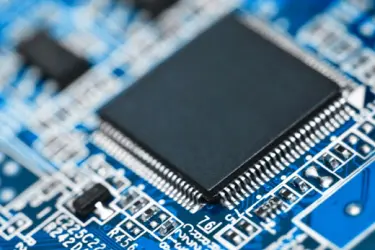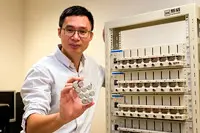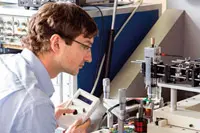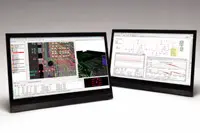Electronics News
Archive : 14 October 2014 год
 Three leading digital power supply companies have formed the AMP Consortium – Architects of Modern Power. CUI, Ericsson Power Modules and Murata Power Solutions say the move has been made for a number of reasons, including supply chain security, customer choice and to accelerate innovation.
Three leading digital power supply companies have formed the AMP Consortium – Architects of Modern Power. CUI, Ericsson Power Modules and Murata Power Solutions say the move has been made for a number of reasons, including supply chain security, customer choice and to accelerate innovation.
The consortium's ambition is 'to define the future of intelligent, distributed, digital power ecosystems'. Mark Adams, senior vice president with CUI, said: "There are three leading companies in the sector and we have come together because, even though we're leaders, our customers have broader needs – one of the first questions we're asked is whether we have second sources for our products."
The consortium's efforts will initially be focused on advanced bus DC/DC converters and point of load converters, but it will look at other areas in the future. The three founders plan to announce their first compatible products at electronica in November, as well as standards and a road map.
Patrick Le Fevre, Ericsson's marketing communications director, added: "Digital power is putting more demand on suppliers to align their software; it's not just about footprint compatibility."
This isn't the first such effort in the power sector; earlier attempts included POLA, which is now inactive, and DOSA – the Distributed Power Open Systems Alliance. "DOSA has attempted to address these issues over the last 10 years, but has mainly addressed the analogue world," Adams noted.
Author
Graham Pitcher
Source: www.newelectronics.co.uk
 Scientists from Nanyang Technological University in Singapore say they have developed a battery that can be recharged to 70% of its capacity in two minutes. The team – led by associate professor Chen Xiaodong, pictured – also believes such a battery will have a lifespan of more than 20 years and be capable of more than 10,000 recharging cycles.
Scientists from Nanyang Technological University in Singapore say they have developed a battery that can be recharged to 70% of its capacity in two minutes. The team – led by associate professor Chen Xiaodong, pictured – also believes such a battery will have a lifespan of more than 20 years and be capable of more than 10,000 recharging cycles.
In its approach, the research team replaced the graphite normally used for the anode in Li-ion batteries with a gel made from titanium dioxide (TiO2). Although TiO2 particles are normally spherical, the scientists developed a way to turn them into nanotubes – and the team says this is what helps to speed the chemical reactions taking place.
NTU professor Rachid Yazami, co-inventor of the lithium graphite anode 34 years ago, said he thought the invention would be the next big leap in battery technology.
"There is still room for improvement and one such key area is the power density – how much power can be stored in a certain amount of space – which directly relates to the fast charge ability. Ideally, the charge time for batteries in electric vehicles should be less than 15 minutes, which Prof Chen's nanostructured anode has proven to do."
The technology is currently being licensed and Prof Chen expects the new generation of fast charging batteries will be launched in two years.
"With our nanotechnology, electric cars would be able to increase their range dramatically with just five minutes of charging, which is on par with the time needed to pump petrol for current cars," Prof Chen said. "Equally importantly, we can now drastically cut down the waste generated by disposed batteries."
Author
Graham Pitcher
Source: www.newelectronics.co.uk
 Engineers at the Technische Universität München believe that future computer chips could be based on 3D arrangements of nanometre scale magnets, instead of transistors.
Engineers at the Technische Universität München believe that future computer chips could be based on 3D arrangements of nanometre scale magnets, instead of transistors.
Using a 3D stack of nanomagnets, the researchers have implemented a majority logic gate, which could serve as a programmable switch in a digital circuit.
In gates made from field coupled nanomagnets, the reversal of polarity represents a switch between logic 1 and logic 0. In the 3D majority gate developed by the researchers, the state is determined by three input magnets, one of which sits 60nm beneath the other two, and is read by an output magnet.
Nanomagnetic circuits are said to have extremely low power consumption, to operate at room temperature, resist radiation and be packed densely.
Author
Graham Pitcher
Source: www.newelectronics.co.uk
 Mouser Electronics has launched MultiSIM Blue, a PCB design integration tool developed in collaboration with National Instruments.
Mouser Electronics has launched MultiSIM Blue, a PCB design integration tool developed in collaboration with National Instruments.
The freely available tool integrates the Berkeley SPICE engine, as well as a preloaded library of popular components from the Mouser database.
Raymond Yin, director of technical content, said: "It's a tool chain that spans from design to purchasing. Engineers will have access to 100,000 components." However, there is a limit of 50 components per design, which Yin doesn't think will be a problem in most cases.
According to Mouser, the package supports prelayout design convergence and mixed signal simulation. It can handle components with more than 1000 pins and pitch sizes down to 0.8mm. MultiSIM Blue also offers 3D visualisation features and access to real time pricing information.
Author
Graham Pitcher
Source: www.newelectronics.co.uk
 LDRA has become a partner and trusted adviser to Microchip Technology in a move that will enable the latter's customers to meet functional safety requirements.
LDRA has become a partner and trusted adviser to Microchip Technology in a move that will enable the latter's customers to meet functional safety requirements.
The partnership will see the LDRA tool suite being integrated with Microchip's MPLAB X IDE and MPLAB XC compilers.
Microchip will recommend LDRA tools for applications that must comply with functional safety standards, including ISO 26262, IEC 61508 and EN 50128.
Author
Graham Pitcher
Source: www.newelectronics.co.uk

